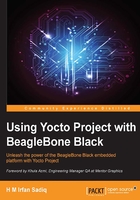
Chapter 1. Welcome to Yocto Project and BeagleBone Black
In this chapter, we will discuss how we can use Yocto Project to bring up BeagleBone. We will discuss the steps that are necessary to set up a host environment for Yocto Project, create images, and set up BeagleBone hardware. We will also discuss how to prepare a card and finally deploy images on the board. Fortunately, BeagleBone is one of the reference boards of Yocto Project, and it makes our lives easier. We can find the core steps for hardware setup in README.hardware, under Poky. There is a lot of information in the Yocto Project Development Reference Manual. What will we be doing here then? The steps given under Poky assume a lot of previous knowledge and sometimes a great deal of generic approach is used there, which isn't very useful for us. We will simplify things here. During this journey, we will pay a visit to different configuration files of Yocto Project and try to develop an understanding of these files. In this chapter, we will:
- Set up a host environment
- Obtain Yocto Project
- Build for BeagleBone
- Learn about configuration files
Setting up a host environment
Before we start getting sources for Yocto Project and building it, we need to prepare our host system. Yocto Project is supposed to work on any distribution of Linux known to us. There is a list of supported platforms available in the Yocto Project Reference Manual (http://www.yoctoproject.org/docs/current/ref-manual/ref-manual.html#intro-requirements).
That is not to say that Yocto Project will not work on other distributions, but the given distributions are the ones on which it is verified to work successfully.
- Ubuntu 12.04 (LTS)
- Ubuntu 13.10
- Ubuntu 14.04 (LTS)
- Fedora release 19 (Schrödinger's Cat)
- Fedora release 20 (Heisenbug)
- CentOS release 6.4, 6.5
- Debian GNU/Linux 7.0, 7.1, 7.2, 7.3, and 7.4 (Wheezy)
- openSUSE 12.2, 12.3, and 13.1
For Poky Daisy 1.6.1, the list is long. We will stick to Ubuntu 14.04 (LTS) for the rest of the book. For this release, package dependencies that need to be taken care of are pided into the following four subcategories.
Essentials
These are the core tools and packages that are required to build Yocto Project. These include a GNU compiler, versioning control system, and other packages that are required to build an environment on host. Here's the command to get the essentials:
$ sudo apt-get install gawk wget git-core diffstat unzip texinfo gcc-multilib \ build-essential chrpath
Graphics
If you want to use graphics support or you intend to use Eclipse IDE, then you need to install these packages:
$ sudo apt-get install libsdl1.2-dev xterm
Documentation
These packages are required if you want to build a Yocto Project documentation:
$ sudo apt-get install make xsltproc docbook-utils fop dblatex xmlto
ADT Installer Extras
These packages are required only if you want to build an Application Development Kit (ADK):
$ sudo apt-get install autoconf automake libtool libglib2.0-dev
If you are using any distribution other than those previously listed, you will find similar commands can be used on Debian distributions, as well. For other supported distributions, consult the Yocto Project Reference Manual.